How is it that out of the 100 or so grape species existing today, only one is responsible for 99 percent of the world's wine? A unique combination of acidity, sugar levels and flavor compounds have made Vitis vinifera (also known as the European, or Old World grape) the only prized wine grape in the world.
Vitis, Latin for vine, is a part of the Family Vitaceae, which also includes the Virginia Creeper, Peppervine and Bushkiller . Vitis vinifera sylvestris, the wild version of our cultivated grape, still grows throughout the Mediterranean basin, in Asia Minor and further east in pockets in Central Asia. Fossil records indicate that 50 million years ago (mya), the wild form of vinifera shared more physical characteristics with other members of the Family Viticeae than it does today. Scientists speculate that a distant relative of vinifera could be Ampelopsis, a climbing vine that existed 500 mya, a time when Earth had only one landmass – the supercontinent known as Pangaea.
|
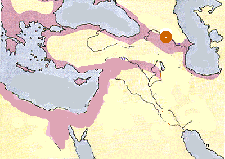 The colored area shows how far vinifera
had spread by Ancient Greek times.
The colored circle indicates what most experts
agree is the birthplace of V. vinifera
It may be impossible to know exactly when and where the grape species V. vinifera first appeared, but archaeological evidence places grape pips in the Trans Caucaus area, dating back to 6000 B.C. This area, located between the Black Sea and Caspian Sea, is believed to be the birthplace of vinifera, and the place where humans first cultivated the grape.
Cultivation of V. vinifera slowly spread outwards to other cultures in the fertile Crescent and the peoples living around the Black Sea. In the early Neolithic period, the Black Sea was a much smaller fresh water sea, and much lower than the Mediterranean Sea. In 5600 B.C., the 20-mile strip of land separating these two seas collapsed, allowing the Mediterranean to spill into the Black Sea, turning it into the size and saltiness we know today. Historians believe this event was the 'Great Flood' mentioned in the Bible and other religious works.
The survivors of that event fanned out of the region, eventually bringing wine grapes into Egypt, Iran and Greece. Vinifera was then carried by the Phonecians and Greeks to southern Italy, southern France and Spain. Then, at the height of the Roman Empire, vinifera was introduced to mainland Europe and the British Isles.
 During the Roman Empire, vinifera was planted all
around the Mediterranean Sea and on mainland Europe.
|
|
Ancient varieties
As vinifera spread throughout the Old World, the chimeric nature of vinifera allowed it to evolve new varieties through spontaneous cross breeding in the vineyards. In addition, winemakers constantly tinkered with the species, trying to fine tune the grape to thrive in new wine growing regions. As the number of varieties increased throughout the Mediterranean Basin, keeping track of grape lineage became problematic. In the 18th through 20th century's, tracing our modern varieties to the ancient grapes proved difficult for historians due to the lack of written information, and to the numerous synonyms used in wine regions around the world. It's not uncommon for the same grape to have a half-a-dozen names. For example, Pinot Gris is also known as Pinot Grigio, Fromentan, Malvoise, Pinot Beurot, Gris Cordelier, and Rulander
Today there are over 4,000 varieties of V. vinifera, though only ten percent of those are regularly used in winemaking. Italy alone boasts over 1,000 varieties, 300 of which are used by Italian winemakers. Many of these grapes have been traced back to ancient grapes brought over by the Greeks and Phoenecians. For example, Fiano is thought by some experts to be the grape used to make Apianum, a popular wine in ancient Rome. Another ancient grape, Falaghina, used to make Falernum, perhaps the most famous of all Romans wines, is still used today to create a modern version of that wine. The Greco vines, used to produce Greco del Tufo, one of Italy's most famous wines, were brought over from Greece and are believed to be the ancestor of the modern Sangiovese grape – the grape used to make Chianti.
In France, ancient grapes that still thrive include Viognier, Roussanne, Rolle and Carmenere, all traceable to Greek and Roman heritage. Many of France's ancient varieties that were pulled after Phylloxera devastated Europe's vineyards in the late 19th century are now making a comeback as wine makers re-discover their heritage.
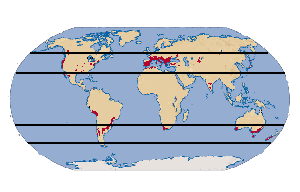
The narrow bands between the dark lines represent
the regions where vinifera thrives, between 30 and 50 degrees latitude.
The red areas indicates today's major winegrowng regions
Vinifera In The New World
During the Great Age of Discovery, explorers and conquerors from the Old World brought vinifera with them, planting vineyards and introducing viticultural practices to virtually every continent.
Explorers from Spain and Portugal introduced wine grapes to Mexico and South America. From Mexico, Spanish padres who traveled into what is now California and Texas, brought the Black Spanish (LeNoir) grape to produce sacramental wines for their missions. As European immigrants seeking freedom and opportunity flowed into North and South America during the 18th and 19th centuries, bringing their grape vines and winemaking experience with them.
As wine's popularity grew in the New World during the 20th century, winegrowers driven by market forces, pulled up some varieties in favor of others, as in the meteoric rise of Merlot and Chardonnay. This resulted in a wine industry, that for the most part, was dependent on a handful of varietals. Even Italy, once considered the last bastion for preserving ancient grapes, planted the noble grapes. Concern has been voiced regarding this 'globalization' of a handful of grapes and whether it best serves the producer or the customer. Fortunately the trend is changing, over the past few years winegrowers are venturing beyond the big six grape varieties and experimenting with lesser known grapes from Italy, Spain and Greece.
The Future Of Vinifera
DNA fingerprinting has allowed scientists around the world to develop a clearer picture of how wine grapes have evolved over time. In 1997, results of genetic testing at University of California at Davis shocked the wine world with the news that the highly esteemed Cabernet Sauvignon grape was the result of a crossing between Sauvignon Blanc and Cabernet Franc, most likely during the Middle Ages. It was common practice to plant a variety of grapes side-by-side in European vineyards, providing the indiscreet vinifera a perfect environment to spontaneously cross-breed.
The wine world was shocked again in 1999 when scientists at UC Davis discovered that Gouias Blanc and Pinot Noir were the parents of 16 well known varietals, including Chardonnay, Aligote and Gamay Noir. How could the lowly Gouais Blanc – a grape once considered so mediocre that attempts were made to ban it – give rise to such nobility? According to UC Davis professor Carole Meredith, "Gouais Blanc and Pinot Noir have been successful parents, perhaps because of their genetic diversity." DNA fingerprinting is underway in Greece, Italy and France as part of an international effort to create a detailed map of vinifera's lineage. The table on the right provides a 'family tree' of some well known modern wine grapes.
We are entering what is predicted to be one of the most prolific grape periods in centuries, due in part to a general warming of the planet. However, too much of a good thing can be dangerous. Research scientists Dr. Gregory Jones and his teammates at the Hadley Center predict an average growing season temperature increase of 2.04 degrees Celsius by 2049, on top of a two degree rise over the last 50 years. According to Jones, the cooler climates would benefit the most, while prized wine regions would feel negative impacts. Their 100-year forecast is even more dire with increased summer temperatures, more extreme weather, and an increase in winter rainfall and decrease in summer rainfall.
In some winegrowing regions, the short term prediction of warming trends is already being felt. In California's Napa and Sonoma Valleys, the climate has become so warm that maintaining acidity and developing flavor profiles have become increasingly difficult. In Germany, researchers predict that red varieties like Merlot and Cabernet Sauvignon will become more suitable for the region by 2050 and
Esca and Black Rot now appear regularly, where 20 years ago such diseases were never seen.
Given climatic changes, the threat of diseases, and fickle planting schemes, should we be be concerned about the fate of vinifera? Hardly. The Family Viticeae survived the Ice Ages, at least two mass-exterminations of life on the planet (250 mya and 60 mya), the breakup of the continents, and the desertification of North Africa, North America and Central Asia. As long as Vitis vinifera sylvestris, still exists, V. vinifera will thrive in spite of warming trends and human meddling. Wine grapes existed long before homo sapiens appeared, and more than likely will be here long after we're gone.
|
|
|
|
"The peoples of the Mediterranean began to emerge from barbarism when they learnt to cultivate the olive and the vine."
Thucydides, Greek historian, fifth century B.C.
Ancient Wines -- not for the timid!
The ancient wines of Greece and Rome would probably be offensive to modern winedrinkers. It was common practice back then to add a variety of things to wine, rather than drink it plain. The Romans liked their wines sugary sweet, and usually added such things as fermented fish sauce, garlic, seawater, resin and spices.
Lesser known Vitis species
Several species of Vitis are indigent to North America, but by-and-large the low sugar levels require additional sugar, while higher acid levels result in a 'foxy' taste.
V. labrusca:
Catawba, Concord & Delaware grapes
V. rotundifolia:
Muscadine and Scuppernong grapes
V. riparia
V. rupestris
V. labrusca grapes are best known for jellies, jams and grape juice.
V. rotundifolia grapes are still used in the South to make mostly sweet wines to hide that 'foxy' taste.
V. Riparia and V. rupestris grapes aren't typically used for wine, but the vines are often used to graft vinifera onto to resist disease.
Examples of Vinifera Lineage
| Grape Variety |
Grape Parents |
| Albalonga |
Riesling X Sylvaner Clone |
| Alicante Bouschet |
Aramon X Teinturier
Grenache X Petit Bouschet |
| Aligote |
Pinot Noir X Gouais Blanc |
| Bacchus |
Muller Thurgau X Riesling X Sylvaner |
| Cabernet Sauvignon |
Sauvignon Blanc X Cabernet Franc |
| Carnelian |
Grenache X Cabernet Sauvignon X Carignan |
| Chardonnay |
Pinot Noir X Gouais Blanc |
| Colombard |
Gouais Blanc X Chenin Blanc |
| Durif |
Peloursin X Syrah |
| Ehrenfelser |
Rieslin X Sylvaner clone |
| Faber |
Weissburgunder X Muller Thurgau |
| Gamay Beaujolais |
clone of Pinot Noir |
| Gamay Noir |
Pinot Noir X Gouais Blanc |
| Kerner |
Riesling X Trollinger |
| Muller Thurgau |
Rielsing X Sylvaner clone |
| Pinotage |
Pinot Noir X Cinsuat |
| Sangiovese |
Ciliegiolo X Montenovo Calabrese |
| Scheurebe |
Riesling X Sylvaner
|
How many grapes in a bottle of wine?
The amount of juice extracted from a harvest varies, but here's a rough guide for a standard (750 ml) bottle of wine:
1 cluster = 40-60 grapes
1 pound of grapes=4-5 clusters
1 ton of grapes = 60 cases of wine
Which equates to 440-660 grapes per bottle
The big six of modern wine grapes:
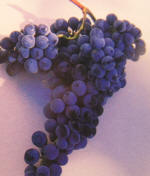
Cabernet Sauvignon
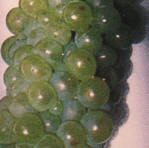
Chardonnay
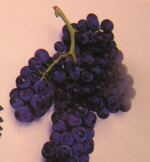
Merlot
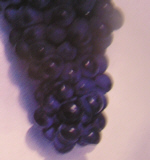
Pinot Noir
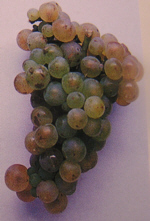
Riesling
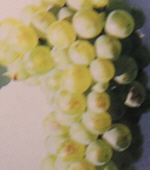
Sauvignon Blanc
|
|
 |